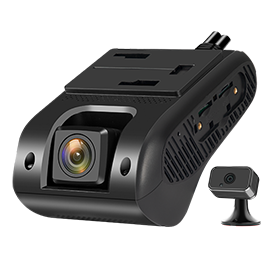In recent years, dash cams have become a staple for drivers, providing essential documentation in the event of an accident or incident on the road. With the rise of fleet management, dual dash cams have become increasingly popular, offering even more benefits for fleet owners and operators. So what exactly is a dual dash cam, and why should you consider one for your fleet? In this article, we’ll delve into the world of dash cam technology, discuss the different types available, and help you choose the best dual dash cam for your needs.
Dash Cam Technology: How Does It Work?
Dash cams, short for dashboard cameras, are small video recording devices mounted on a vehicle’s dashboard or windshield. They continuously record the view through the vehicle’s front and/or rear windows while the vehicle is in motion. This footage is typically stored on an SD card and can be later retrieved for review or evidence purposes.

A dual dash cam is a type of dash cam that records both the front and rear views of a vehicle. These cameras usually have two separate lenses – one facing forward and another facing the rear. Dual dash cams provide a comprehensive view of what’s happening around your vehicle, which can be especially useful for fleet management.
Types of Dash Cams
While dual dash cams are the focus of this article, it’s essential to understand the different types of dash cams available:
- Single-lens dash cams: These dash cams only have one lens and record the view of the road in front of the vehicle. They are the most basic and affordable option.
- Dual dash cams: As mentioned earlier, dual dash cams have two lenses and record both the front and rear views of the vehicle. They provide added benefits, such as capturing rear-end collisions or incidents happening behind the vehicle.
- Dash cams with GPS tracking: Some dash cams come with built-in GPS tracking, allowing fleet managers to monitor their vehicles’ locations and routes in real-time. This feature is particularly useful for managing larger fleets and ensuring efficient route planning.

Benefits of a Dual Dash Cam for Your Fleet
There are several advantages to using a dual dash cam in your fleet, including:
- Comprehensive coverage: A dual dash cam provides a complete view of the road, capturing incidents that a single-lens dash cam might miss. This can be crucial in determining fault and liability in case of an accident.
- Enhanced driver safety: Dual dash cams can help improve driver safety by encouraging responsible driving behavior. A study conducted by the Virginia Tech Transportation Institute found that the use of dash cams can lead to a 20% reduction in accident frequency and a 35% reduction in accident severity.
- Reduced insurance premiums: Many insurance companies offer discounts to fleet owners who install dual dash cams in their vehicles. This can result in significant savings on insurance costs for your fleet.
- Improved driver training: The footage captured by dual dash cams can be used to identify areas where drivers need improvement, such as harsh braking, speeding, or tailgating. This data can be invaluable for refining and enhancing driver training programs.
Choosing the Right Dual Dash Cam for Your Fleet
When it comes to choosing the best dual dash cam for your fleet, consider the following factors:
- Video quality: Look for a dual dash cam that offers high-definition video quality, ideally 1080p or higher. This will ensure that the footage is clear and detailed, making it easier to identify license plates and other important information in case of an incident.
- Night vision: Accidents can happen at any time, so it’s essential to choose a dual dash cam that performs well in low-light conditions. Look for models with infrared LEDs or other night vision features.
- Storage capacity: Make sure the dual dash cam you choose has ample storage capacity, as high-quality video files can be quite large. Look for models that support SD cards with a capacity of 64GB or more.
- GPS tracking: If you want to track your fleet’s location and routes, opt for a dual dash cam that includes GPS tracking features.
- Ease of installation: Look for a dual dash cam that is easy to install and doesn’t require professional assistance. Many models come with simple suction cup mounts or adhesive pads, making it easy to attach the camera to your vehicle’s windshield or dashboard.
In conclusion, investing in a dual dash cam for your fleet can provide numerous benefits, including improved driver safety, reduced insurance costs, and enhanced driver training. By understanding the different types of dash cams available and considering the essential features, you can choose the best dual dash cam to meet your fleet’s needs and ensure a safer, more efficient driving experience for all.
 EN
EN ES
ES PT
PT TH
TH VN
VN JP
JP


